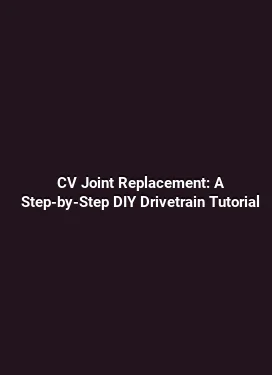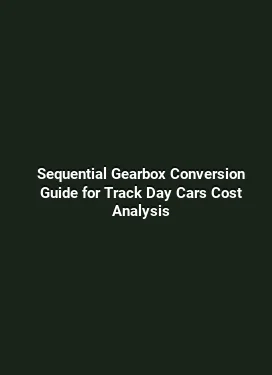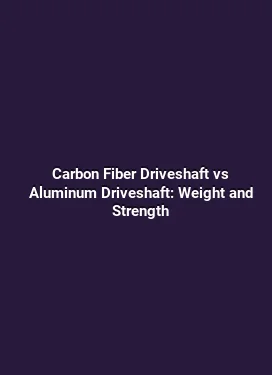Prop Shaft Balancing: Why Drivetrain Vibration Occurs and Fixes
Understanding Drivetrain Vibrations: The Role of the Prop Shaft

Drivetrain vibrations arise from a complex interaction of rotating components, misalignment, and dynamic forces transmitted from the engine to the wheels. The prop shaft, also known as the drive shaft, acts as a critical bridge between the transmission and the differential. When its balance is disrupted, you can feel rhythmic shaking, especially at highway speeds or under steady torque. The balancing process mitigates these oscillations by ensuring the shaft’s mass distribution is uniform around its axis, reducing harmonic excitations and preventing premature wear on bearings, universal joints, and mounts.
Balanced prop shafts minimize energy losses and enhance comfort by reducing tremors that travel through the floor, steering wheel, and seat frames. In many modern vehicles, theprop shaft is designed with precision manufacturing, but on-road conditions, road debris, or accelerated braking can disturb balance. The result is a perceptible vibration at specific RPM ranges, which often correlates with rotational speeds where resonant forces amplify the shaft’s natural frequencies. Understanding these dynamics is the first step toward diagnosing and fixing driveline vibrations accurately.
Key Mechanisms Behind Shaft Imbalance
Imbalance originates from mass distribution deviations along the shaft’s length. Even a small angular misalignment or a heavy spot causes gyroscopic effects as the shaft spins. Several factors contribute to imbalance: manufacturing tolerances, wear in the slip joint or universal joints, bent shafts from impacts, or accumulated residue such as rust and a buildup of debris near critical balance zones. Additionally, the presence of non-uniform lubrication or excessive bearing play can modify the effective mass distribution temporarily, changing the vibrational profile while driving.
In practical terms, imbalance manifests as axial and radial runout. Radial runout refers to variations in the shaft’s radius from end to end, while axial runout involves deviations along the shaft’s centerline. Both contribute to periodic fluctuations in rotational inertia, which translate into alternating forces that your drivetrain and chassis must absorb. Understanding the interplay between runout, resonance, and drive torque helps pinpoint whether the problem originates in the prop shaft or another component in the drivetrain.
Measuring and Diagnosing Shaft Balance: Tools and Techniques
Accurate diagnosis starts with robust measurement. Diagnostic methods range from practical road tests to precise instrumentation. A common approach is a road force or dynamic balancing test, often performed with a balancing machine in a shop setting. The technician may attach trigger magnets or high-contrast markers to observe vibration patterns on a tachometer or vibration analyzer, correlating peaks with specific RPM bands. For in-situ checks, a two-channel accelerometer system can monitor vibrations along multiple axes, revealing whether the primary vibration aligns with the shaft’s rotational plane.
Diagnostics also involve inspecting related components for wear or misalignment. U-joints, constant velocity joints, and the slip yoke must operate freely without binding. A misaligned universal joint can cause side-to-side wobble that imitates a balance issue even when the shaft itself is well balanced. Shaft runout gauges and dial indicators are used to quantify deviations, while laser alignment tools help ensure the drivetrain’s vantage points are co-linear. In some cases, vibration persists at certain speeds despite a perfectly balanced shaft; this indicates resonance with the vehicle’s suspension or engine mounts, guiding the technician to broader diagnostic avenues.
Practical steps for assessing balance in a workshop

Begin with a visual inspection of the prop shaft for dents, bends, or mounting misalignment. Remove any debris and confirm that mounting hardware is torqued to specification. Next, check the universal joints for play or stiffness, verifying that they return to center without binding. If the shaft passes these checks, a shop can perform a dynamic balance on a balancing machine, which may reveal a heavy spot requiring correction via weights placed at precise azimuth positions. Record the balance results and compare against OEM tolerances to determine if further adjustments or replacement is warranted.
Common Fixes: Balancing Methods, Upgrades, and Adjustments
Balancing methods vary based on vehicle design, shaft length, and payload. Static balancing places weights to neutralize the heaviest side of the shaft so it remains upright when stationary. Dynamic balancing, more common for modern shafts, corrects imbalance in multiple planes, compensating for both lateral and angular deviations. For severe imbalances, a shaft may require resizing, straightening, or replacing worn components such as the yoke or U-joints. In some cases, balancing involves adding or removing material to achieve the target inertia distribution, though material removal is rare and typically limited to factory-grade shafts under controlled conditions.
When addressing driveline vibrations, it is essential to consider ancillary parts that influence balance. A misaligned exhaust system can create additional resonances that pair with the shaft’s natural frequency, magnifying vibrations. Engine and transmission mounts, if worn or softened, fail to dampen the forces transmitted through the chassis. Upgrading to higher-quality mounts or installing anti-vibration bushings can complement shaft balancing for a smoother ride. In performance applications, aftermarket performance driveshafts designed with optimized balance and lower inertia may further reduce vibration without sacrificing strength.
Balancing in Different Drivetrain Configurations
Rear-wheel drive (RWD) systems present different balancing challenges than front-wheel drive (FWD) configurations. In mid-engine or all-wheel-drive (AWD) layouts, prop shafts may span multiple gearboxes or transfer cases, introducing additional joints and potential misalignment points. In AWD systems, uneven torque distribution and variable slip across different drive shafts can cause one shaft to experience higher dynamic loads, necessitating careful multi-shaft balancing and cross-checks with synchronized vibration analysis across all rotating components.
Preventive Maintenance: Extending the Life of the Prop Shaft and Drivetrain
Preventive maintenance reduces the likelihood of imbalance-related vibrations developing over time. Regular inspection of the prop shaft’s U-joints, bearings, and yokes helps detect wear before it translates into significant vibration. Ensuring proper lubrication of joints and verifying differential fluid condition can help the drivetrain absorb torque pulses more evenly. Additionally, checking for alignment drift due to suspension wear or frame flex during heavy loads prevents gradual shifts in balance from going unnoticed.
Road conditions and driving style contribute to imbalance onset too. Hitting potholes, speed bumps, or curbs can bend or dent the driveshaft, create flat spots, or loosen mounting flanges. A disciplined maintenance routine includes periodic checks after major road incidents and after any suspension or exhaust modifications. For vehicles used in demanding environments—towing heavy loads or off-road duty—more frequent diagnostics and potential pre-emptive balancing can maintain ride quality and protect driveline components from abnormal stress.
Real-world scenarios: balancing in practice
Consider a mid-sized SUV experiencing a noticeable vibration at 60–70 mph, with a steady pedal feel and a mild steering wheel shake. A technician starts with a dynamic balance, discovering a weighted correction in the outboard section of the driveshaft. After rebalancing, the symptom diminishes, but a residual vibration persists at a different RPM band. A further inspection reveals slight wear in one U-joint. Replacing the worn joint and performing a second-pass balance yields a near-elimination of vibration. In this case, balancing addressed the symptom, while component wear was the underlying progressive cause that required attention to ensure long-term reliability.
Important Considerations: Compatibility, Materials, and Engineering Trade-offs
Driveshaft materials range from steel to aluminum or composite constructions. The choice influences mass distribution, stiffness, and natural frequencies. Aluminum shafts are lighter but can be more sensitive to dents and surface imperfections, affecting balance more noticeably. Composite driveshafts offer high strength-to-weight ratios and corrosion resistance but may exhibit different balance characteristics that require specialized equipment. When selecting a replacement or upgrade, it is essential to match the shaft’s length, diameter, and joint geometry to the OEM configuration and the vehicle’s torque profile. Mismatches can exacerbate vibrations rather than resolve them, even if the shaft appears visually correct.
Engine torque curves and transmission behavior also interact with shaft balance. High-torque applications can amplify imbalances that would be negligible under lighter loads. In performance tuning, engineers may pursue balancing strategies that account for transient torque spikes, ensuring the drivetrain remains smooth across accelerations and decelerations. In everyday driving, a balanced prop shaft contributes to reduced mechanical loss and improved fuel efficiency, which are benefits beyond mere comfort.
Practical tips for owners and technicians
owners should document vibration symptoms, RPM ranges, and load conditions when they occur, aiding the diagnostic process. Technicians can use a phased approach: verify the shaft’s balance, inspect joints and mounts, then evaluate resonance with a vibration analysis. If a vibration reappears after a balancing fix, broaden the investigation to include exhaust routing, engine mounts, and accessory belts that may introduce secondary resonances. A comprehensive approach prevents misattribution of vibration sources and avoids unnecessary part replacements.
Emerging Trends: Sensor Fusion and Predictive Maintenance
Advances in sensor technology and data analytics enable continuous monitoring of driveline health. Modern vehicles may incorporate accelerometers, gyroscopes, and battery management data to detect subtle shifts in vibration signatures over time. Sensor fusion techniques combine measurements from multiple points along the drivetrain to create a more accurate picture of balance status. These tools facilitate predictive maintenance, allowing owners to schedule bearing replacements or balancing service before vibration escalates into costly repairs. The integration of OTA updates with diagnostic software ensures that calibration models improve as new vehicle data becomes available, helping technicians stay ahead of wear-induced balance issues.
Implementation considerations for workshops
Workshops can adopt modular balancing equipment that supports a range of shaft diameters and joint configurations. Training on dynamic balancing procedures, understanding multi-plane corrections, and interpreting phase angles helps technicians optimize outcomes. When logging service data, recording balance corrections, weights added, and measured runout in a structured format supports traceability and quality control. For shops looking to differentiate themselves, offering a certified balancing service with a demonstrated vibration reduction can build trust with customers facing driveline concerns.
Conclusion: A Holistic View of Prop Shaft Balancing
Prop shaft balancing is a nuanced discipline that blends precise measurement, mechanical understanding, and practical maintenance. While balancing the shaft is often the most visible remedy for driveline vibrations, a comprehensive strategy that includes joint inspection, mount integrity, and resonance analysis yields the most durable results. By approaching vibration issues with a methodical mindset and leveraging modern diagnostic tools, technicians can restore smooth operation, extend component life, and preserve driving comfort across a wide range of vehicles and usage scenarios.






